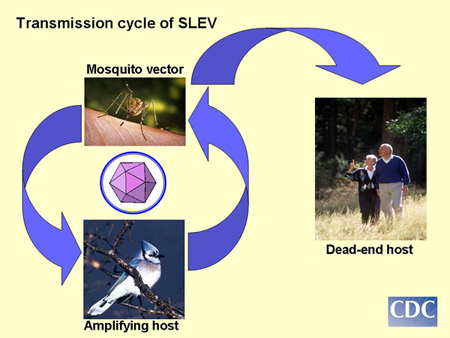St. Louis encephalitis virus (SLEV) is an arthropod-borne virus (arbovirus) that is primarily transmitted in Indiana by mosquitoes in the genus Culex. While most people who become infected with SLEV do not develop any symptoms, some people can develop severe inflammation in the brain, spinal cord, or other parts of the nervous system.

St. Louis encephalitis virus. Centers for Disease Control and Prevention.
- Transmission
SLEV is transmitted in Indiana by mosquitos in the genus Culex. Mosquitoes become infected when they feed on wild birds. Infected mosquitoes can then spread SLEV to people and other mammals. Once infected, people and other mammals are “dead-end hosts,” which means that they do not pass the virus on to other biting mosquitoes.

SLEV transmission cycle. Graphic: Centers for Disease Control and Prevention.
- Signs and Symptoms
Most people (about 99%) infected with SLEV do not develop any symptoms.
Some people (about 1%) develop a fever and other symptoms. For people with symptoms, the time from infected mosquito bite to feeling sick (incubation period) ranges from 4 to 14 days. The disease is generally milder in children and young adults than in older adults.
- Symptoms usually start abruptly, with fever, headache, dizziness, nausea, and generalized weakness.
- Signs and symptoms usually get worse over a period of several days to a week.
- Some patients recover after this period.
- Others develop signs of central nervous system (CNS) infections, including inflammation of the brain (encephalitis) or the membranes around the brain and spinal cord (meningitis).
- Symptoms can include stiff neck, confusion, disorientation, dizziness, tremors, and unsteadiness.
- Coma can develop in severe cases.
- Among patients diagnosed with St. Louis encephalitis, 5 to 20% die.
- The risk of dying from SLEV CNS infections increases with age.
- Diagnosis
Diagnosis of SLEV disease is based on the patient’s signs and symptoms and appropriate laboratory testing. If you think you have SLEV disease, contact your healthcare provider.
- Treatment
No specific medication is available to treat SLEV disease. People with severe illness usually require hospitalization, supportive care, and/or rehabilitation.
- Prevention
The best way to prevent SLEV disease is to avoid mosquito bites. Please see our mosquito prevention page for more information.
For more information about St. Louis encephalitis virus, visit the CDC SLEV webpage.
- Maps and Statistics
SLEV disease is rare in Indiana with no cases reported in the past 10 years. For more information about infectious diseases in Indiana, please visit:
For maps showing recent mosquito-borne disease detections in people, horses, and mosquitoes, click here.
National statistics for SLEV disease can be found at the CDC SLEV Statistics and Maps webpage.
- Resources
Information for Providers
For SLEV disease diagnosis, treatment, and testing information, click here.
Page Last Updated: August 30, 2024
